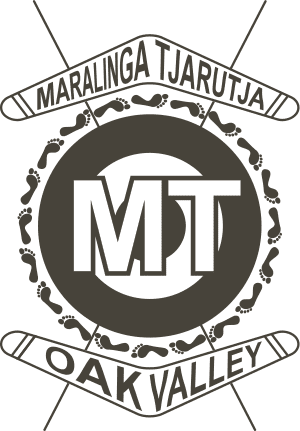Your cart is currently empty!

Historical Overview
Aboriginal people have occupied the Maralinga Tjarutja lands since time immemorial. The land offers cultural, social, economic and spiritual significance for the Maralinga people. However, the recent history is one involving the displacement, alienation and disenfranchisement of the traditional owners, culminating in a long struggle to reclaim their land and culture.

The people are part of the Western Desert culture. They have strong cultural and traditional links with the Pitjantjatjara and Yankunytjatjara people to the north and the Tjuntjuntara people to the west.
The land supported the hunter-gatherer society and had well-travelled routes across the country with soaks and rock holes for the collection of water. Ooldea, being a rare source of semi-permanent fresh water, was the focus of many traditional activities and an important meeting and ceremonial site.
Ooldea has subsequent prominence through European intrusion as:
- A site on the east-west railway line opened in 1917;
- The campsite of Mrs Daisy Bates – 1919-1936;
- As a mission and school site established by Ms. Annie Lock in 1933 that was administered by the United Aboriginal Mission until its closure in 1952, and
- A gazetted Aboriginal Reserve.
Displacement
The displacement of the traditional owners from the land was ultimately brought about by the desire of the British (and Australian Governments) to test atomic weapons.
When Ooldea Mission was closed in 1952 (due to a rift in mission management) the traditional owners dispersed back across their country. But people were rounded up and relocated to Yalata – operating as a Lutheran mission since the Government purchased Yalata Station the previous year. Others went to Koonibba and Tjuntjuntara (in WA).
The government advised the people that they could not return to their Maralinga lands and in May 1953, the government announced that atomic weapons would be tested.
The 1st two tests were at Emu Junction (about 180kms north of Ooldea) in September 1953 but the site was considered unsuitable and abandoned, shortly after.
The preferred site was land surveyed by Len Beadell and Sir William Penney about 100 km south of Emu that became known as the Section 400 – Maralinga Prohibited Area. Part of this land encroached on the northwest corner of the Ooldea Aboriginal Reserve and at the request of Prime Minister Menzies, South Australia’s Premier Thomas Playford de-gazetted the reserve in Nov 1953 and the atomic program commenced in 1956.
Although the Traditional Owners were prohibited from the Maralinga Prohibited Area, it was later revealed that many people still traversed the land throughout the atomic testing period. The most notable example occurred in May 1957 when a family was discovered camped at the bottom of the crater at the 2nd test site, the Marcoo atomic bomb.
Reclaiming the Land
In April 1984, after a long struggle with the South Australian government, 76,420 km sq of land was handed back to Maralinga Tjarutja Inc., under terms within the Maralinga Tjarutja Lands Right Act of SA.
However, people could not return to Section 400 because this land was excluded from the Act and it wasn’t until early Nov 2014 that this land was finally transferred back from the Federal Government.
Royal Commission, Compensation and Clean-up
A Royal Commission into the British Nuclear Tests in Australia was conducted between July 1984 and December 1995.
Although not the intended purpose of the Commission, the risk to Traditional Owners from the residual radiation at both the Maralinga and Emu test sites became a major issue. It became clear that a further ‘clean up’ of the site was required, beyond what had been attempted by the British and Australian governments in the 1960s. In 1986 the Australian Government established a Technical Assessment Group to undertake a risk assessment of the condition of the lands.
A key task of the TAG was to assess the risk of residual radioactive contamination on Aboriginal people living traditional and semi-traditional lifestyles.
The main risk assessment issues related to two areas of land within Section 400:
- The Burial Pits at the Taranaki test site, which were believed to contain between 2 and 20 kilograms of plutonium, and
- An area of about 200 km sq of land north of Taranaki that was lightly contaminated with plutonium plumes.
These sites were considered to be a risk to traditional people if they lived for extended periods on this land.
The outcome of negotiations between the Commonwealth government and Maralinga Tjarutja Inc. was that the people would accept the recommended remedial treatments for these areas, but were to be compensated for the loss of use and enjoyment of this land.
The compensation agreement was deferred until the British and Australian Governments finalised their negotiations about sharing the costs of the proposed cleanup. Some of the key outcomes of the final report, in June 1995 were that the Australian Government agreed to:
- Clean up Section 400 lands, to the standard determined by the Technical Assessment Group;
- Make Section 400 available for return to Maralinga Tjarutja Inc., on completion of the clean-up;
- Assist Maralinga Tjarutja Inc. in pursuing tourism and other opportunities relating to the nuclear test sites.
The clean-up was finally completed in 2000.
Source: Extract from Maralinga Village Feasibility Study, Ochre Consultants P/L, 2002